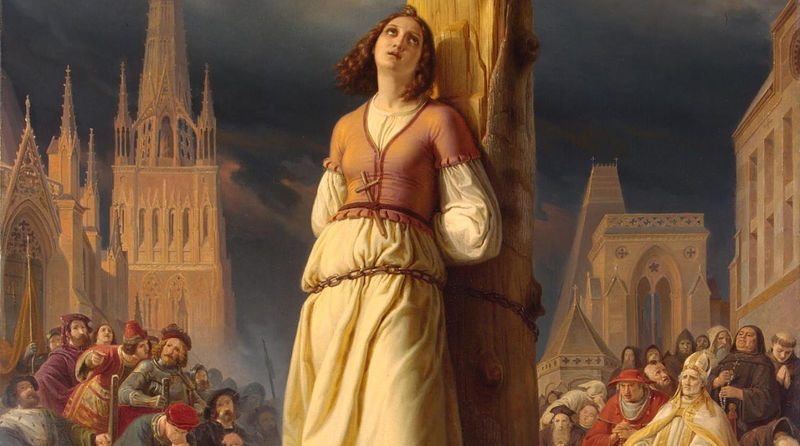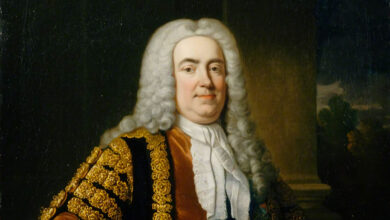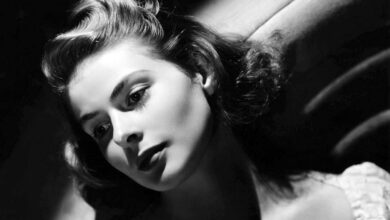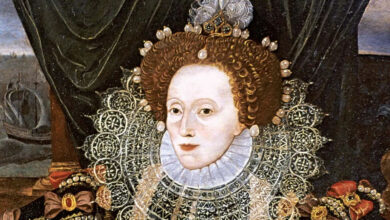
Podcast: Play in new window | Download
Subscribe: Spotify | Amazon Music | Youtube Music | RSS
“I would rather die than do something which I know to be a sin, or to be against God’s will.” – Joan of Arc
Joan of Arc was born to parents Jacques d’Arc and his wife Isabelle in the year 1412 in a village called Domrémy in France, which has since changed its name to Domrémy-la-Pucelle in honour of Joan’s nickname la Pucelle d’Orléans, the Maid of Orléans.
Joan’s parents were poor tenant farmers who tended the land in north-eastern France during the Hundred Years War, which was a conflict between France and England that had begun over an inability for two related royal families to determine who should be heir to the French throne. The war had been going on since 1337 and by the time of Joan’s birth, France was a dangerous, lawless place to live.
During her early life, Joan never ventured far from home and she learned domestic skills from her mother, becoming an excellent seamstress whilst also helping to look after the animals.
When Joan was three, the forces of King Henry V of England invaded northern France and struck a decisive blow against the French after receiving support from Burgundy. The result was the Treaty of Troyes which, in 1420, granted Henry V the right to rule France as regent for King Charles VI who had been declared insane, with the understanding that he would inherit the French throne when Charles died. However, only two years later both Charles and Henry died within months of each other and the supporters of the future Charles VII, the infant son of the now-dead Charles VI saw an opportunity to return the throne to the French.
During this time, Joan, who was now ten years old began experiencing visions of St. Michael and St. Catherine during which she was declared to be the saviour of France. The visions implored her to seek an audience with the Dauphin to ask his permission to expel the English from France so that he could be installed as the rightful king.
In May 1428 Joan’s visions had become so strong that she took action and sought an audience with Robert de Baudricourt, a garrison commander and supporter of the Dauphin. At first, he refused to see her but after witnessing the support she had gained from the local community, in 1429, he granted Joan’s request to speak with the future king. He supplied her with a horse and a military escort whilst she cropped her hair and donned men’s clothes for the 11-day journey to Chinon, the site of Charles’ court.
At first, Charles did not know what to make of this young peasant girl who had described visions that had professed her to be the saviour of France, so he set her a test. When Joan successfully identified the Dauphin, who was hidden in plain clothes amongst other members of the court, he agreed to meet with her. During their meeting, Joan gave details to the Dauphin of a solemn and private prayer he had made to God asking for the salvation of France. After the Dauphin had also had Joan examined by a group of prominent theologians who found nothing improper with her, he gave the 17-year-old girl a horse and armour and allowed her to accompany him to Orléans where the English were besieging the city.
A series of battles took place over three days beginning on 4 May 1429, during which Joan was wounded, although she recovered enough to return to the front line in time for the final assault. The French forces were successful and by the middle of June, the English had been routed. On 18 July 1429, the Dauphin was crowned Charles VII in Reims with Joan at his side.
The following year, the new King sent Joan to Compiègne to take on the Burgundians but during the battle, she was thrown from her horse and was captured. The Burgundians handed her over to the English in exchange for 10,000 francs who in turn handed her over to the church. Joan was put on trial by the pro-English bishop Pierre Cauchon who charged her with over 70 counts including witchcraft and heresy. During her imprisonment, Joan was held in a military prison and was interrogated more than a dozen times between 21 February and 24 March 1431.
On 29 May the same year, the tribunal headed by Cauchon declared Joan of Arc guilty of heresy and she was sentenced to death. The following morning Joan was burned at the stake in Rouen in front of a crowd of 10,000 people. She was 19 years old.
The Hundred Years War lasted for another twenty-two years and Charles managed to hold on to his crown. Almost immediately afterwards a posthumous examination of Joan’s trial was ordered, having been authorised by Pope Callixtus III following a request by Joan’s mother. The intent of this new trial was to determine if the first trial had been conducted fairly and justly. The Inquisitor-General, Jean Bréhal presented his findings in 1456, the summary of which considered Joan to be a martyr and even that Pierre Cauchon had himself been guilty of heresy. Joan of Arc was declared innocent on 7 July 1456. She was beatified in 1909 and was canonised as Saint Joan on 16 May 1920 by Pope Benedict XV.
Podcast: Play in new window | Download
Subscribe: Spotify | Amazon Music | Youtube Music | RSS




